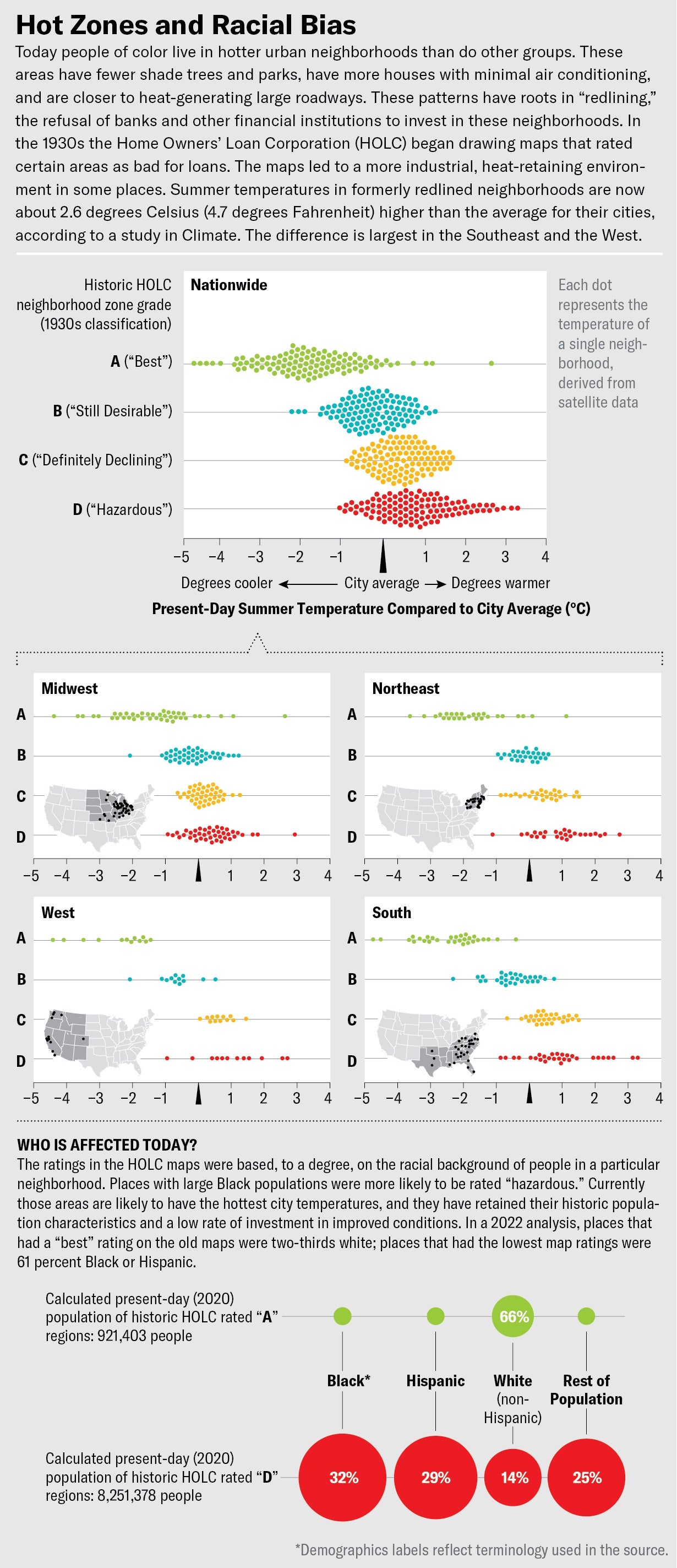On a July day in 2021 that would become blazing hot, dozens of community volunteers gathered before sunrise at the Scrap Exchange, a reuse center for art materials in Durham, N.C. Using heat-sensing instruments, they fanned out along prescribed routes through the city, collecting data on air temperature and humidity in the morning, afternoon and evening.
The survey was part of a project by the National Oceanic and Atmospheric Administration to identify neighborhoods with really high summer heat levels. The results showed temperatures in historically Black neighborhoods were seven to 10 degrees Fahrenheit higher than in affluent areas where more white people lived.
Blocks in these Black neighborhoods had far less shady tree cover than other areas, which were leafy and green. “The 10-degree difference between locations within two miles of each other was surprising,” says Durham County sustainability manager Tobin Freid. She added that the hot areas don’t cool off much at night.
Treeless, breezeless tracts of hot concrete and pavement within cities have become known as urban heat islands. They are not healthy places. The consequences of extreme heat for the human body include cramps, exhaustion and heatstroke. It can amplify existing health conditions such as diabetes, asthma and chronic obstructive pulmonary disease, as well as push up rates of suicide, depression and premature births.
Extreme heat and heat islands are not unique to the U.S. Using data from 93 European cities, a 2023 Lancet study attributed more than 4 percent of deaths in those areas during the summer months to urban heat islands. The paper concluded that one third of these excess heat deaths could be prevented by a tree cover of 30 percent. Another analysis found that Kolkata and Mumbai in India and Manila in the Philippines were among the cities with the largest annual increases in extreme heat exposure worldwide between 1983 and 2016.
A growing body of research shows that people of color and people living below poverty levels are stuck in these islands, much more so than their white and wealthier counterparts. The disparity is most pernicious during the summer, when extreme heat waves are becoming more common and lasting longer. “The average person of color lives in a census tract with higher summer daytime SUHI [surface urban heat island] intensity than non-Hispanic whites in all but 6 of the 175 largest urbanized areas in the continental United States,” wrote the authors of a 2021 study in Nature. A new analysis of 481 U.S. cities showed that the typical Black resident lives in air that is 0.5 degree F warmer than the average for their city. In contrast, the typical white resident lives in air that is 0.4 degree cooler than the city average. These patterns also follow wealth and poverty levels.
“It’s expensive to keep your home cool, and it’s even more expensive if you’re in an urban heat island,” says Jane Gilbert, who leads heat protection programs in Miami-Dade County in Florida. “About 70 percent of lower-income populations live in rental apartments with small wall units that landlords are under no obligation to repair or replace.”

The patterns that led to urban heat islands are linked to redlining. In the 1930s the federal Home Owners’ Loan Corporation began ranking a neighborhood’s loan-worthiness based primarily on its racial composition and socioeconomic status. The policies reinforced segregation, exposed poor communities to industrial pollution, and limited investments in amenities such as trees and parks. A 2020 study of 108 cities in the U.S. found that 94 percent had elevated land-surface temperatures in formerly redlined areas compared with their nonredlined neighbors. The difference was as much as 12.6 degrees F.
Although redlining may no longer be practiced legally, its legacy remains. In the neighborhoods it affected, there are far fewer parks, homes are less energy-efficient, and pollution rates are higher. Structures tend to be more densely packed, which limits air circulation and drives up temperatures.
Cities without a history of redlining have similar disparities, says climate scientist Angel Hsu of the University of North Carolina at Chapel Hill. “It’s due to something wider, more pernicious and systemic,” she says. “It’s environmental racism.” Busy roadways and factories that heat the air are often placed in low-wealth communities of color, which lack the economic and political power to keep such things out.
As climate change makes the world warmer, dealing with urban heat islands is becoming a more urgent matter. In 2021 President Joe Biden launched a coordinated effort to respond to extreme heat. It included guidance for heat exposure limits from the Occupational Safety and Health Administration. (Many states have yet to adopt them.) The recent $1.2-trillion federal infrastructure package encourages investments in green construction and other practices to lower temperatures and improve air quality. And a 2023 federal grant program includes $1 billion to plant trees in urban areas.
Miami-Dade County has launched a multilingual public information campaign and started training community health-care practitioners and disaster volunteers to deal with heat-related illnesses. The county also purchased 1,700 energy-efficient air-conditioning units to install in public housing and is working toward a goal of 30 percent tree canopy. Atlanta and New Orleans created new zoning regulations and set sustainable-development goals that specifically address urban heat effects.
“We have a lot of great research that we need to mobilize into feasible and effective policy solutions,” says Ashley Ward, a researcher at Duke University’s Nicholas Institute for Energy, Environment & Sustainability. To build support, she recommends talking about issues that resonate across different political ideologies—such as health outcomes and their ties to where people live.
This article is part of “Innovations In: Environmental Health Equity,” an editorially independent special report that was produced with financial support from Takeda Pharmaceuticals.
